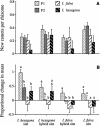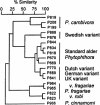Transfer and origin of adaptations through natural hybridization: were Anderson and Stebbins right?
- PMID: 15004269
- PMCID: PMC540259
- DOI: 10.1105/tpc.160370
Transfer and origin of adaptations through natural hybridization: were Anderson and Stebbins right?
Figures




References
-
- Anderson, E. (1948). Hybridization of the habitat. Evolution 2, 1–9.
-
- Anderson, E. (1949). Introgressive Hybridization. (New York: John Wiley and Sons).
-
- Anderson, E., and Hubricht, L. (1938). Hybridization in Tradescantia. III. The evidence for introgressive hybridization. Am. J. Bot. 25, 396–402.
-
- Anderson, E., and Stebbins, G.L., Jr. (1954). Hybridization as an evolutionary stimulus. Evolution 8, 378–388.
-
- Arnold, M.L. (1992). Natural hybridization as an evolutionary process. Annu. Rev. Ecol. Syst. 23, 237–261.
Publication types
MeSH terms
Personal name as subject
- Actions
- Actions
LinkOut - more resources
Full Text Sources

